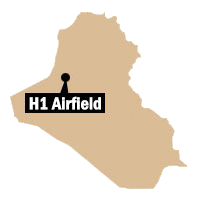Jumpmaster Sergeant First Class Ronald Redmond (pseudonym), 3rd Platoon Sergeant of A/3/75th, led the Rangers in his plane through the jump commands and then the Ranger Creed, a 3rd Battalion tradition carried on from their combat jumps into Panama during Operation JUST CAUSE, and later at Objective Rhino in Afghanistan during Operation ENDURING FREEDOM.3 Commands reviewed and creed recited, the Rangers were ready to jump.
The jump light flashed green and the Rangers exited the aircraft without incident. As each man entered into the uncertainty of the cold, dark, Iraqi desert night, his fate depended on the wind, gravity, and, in some cases, luck. SSG Barker had just enough time to lower his rucksack before he executed a parachute landing fall. Almost immediately, he heard the telltale noise of someone landing to his right, and knew from the sound that the newcomer was hurt. After securing his gear, Barker moved toward the noise. He quickly discovered that the unlucky Ranger had blown out his knee on a patch of hard rocky sand with large jagged rocks intermittently sticking out of the ground. Barker called in the injury to the medics, and verified that the Ranger was stable and did not have any other injuries before continuing with his mission.
Barker’s platoon leader, First Lieutenant David Hess (pseudonym), exited the aircraft without a problem, but hit the ground with a numbing jolt. He felt somewhat disoriented, but began to secure his equipment in what he thought was just a few minutes after landing. However, when Hess came up on the platoon’s radio net, his radio operator told him it had been about twenty minutes since they’d jumped. Shaken, but not out of action, Hess rejoined his platoon.4
Recovering as quickly as possible from the jump, the Rangers moved quickly to their designated assembly areas. Although prepared for an enemy force on the drop zone, they noted no tracer fire or enemy activity. Even the Rangers’ night vision goggles (NVGs) revealed little in the dense darkness. SSG Barker could make out dark spots throughout the area, but no detail. Later, he discovered that these were rocks, piles of sand, or the rusted hulks of armored vehicles used to block the runway. As SSG Barker moved up the runway toward his platoon’s assembly area, he noticed equipment the Iraqis had used to block the runway.
Accompanying the Rangers was a heavy drop of engineer equipment and the same engineers from B Company, 27th Engineer Battalion, who had participated in the rehearsal at Fort Bragg. The engineer equipment landed badly, so the first task for the engineers was to get their equipment into operation in order to clear the runway for the follow-on air land forces.
Although there was no enemy gunfire, the radio net was filled with status reports—mostly injuries, including several from Barker’s squad. One of SSG Barker’s SAW (squad automatic weapon) gunners, a former Marine named Derek, came on the radio and very calmly stated that he may have broken his ankle upon landing in a patch of jagged rocks. “Broken” was an understatement. Using the infrared light on his NVGs, SSG Barker saw that Derek had an open compound fracture just above the ankle, so severe the bones had punctured through his boot, pants, and chemical protective suit. Barker called in the casualty report to the platoon sergeant, and requested one of the “quads” (four-wheeled vehicles) that had been heavy-dropped specifically for casevac (casualty evacuation). The quad soon arrived and took Ranger Derek to the casualty control point.
Once gathered in their platoon assembly areas, the Rangers moved to their assigned objectives. In the case of 3rd Platoon, their objective was a series of bunkers that turned out to be several cement slabs that had once been used as taxiways for fighter jets. With no visible enemy threat, they moved to their final security points on the perimeter of the battle position. From their battle positions, the Rangers watched as the engineers worked feverishly to clear the runway for follow-on air land forces. Their perseverance and hard work paid off and within five hours the airstrip at H1 was operational.


